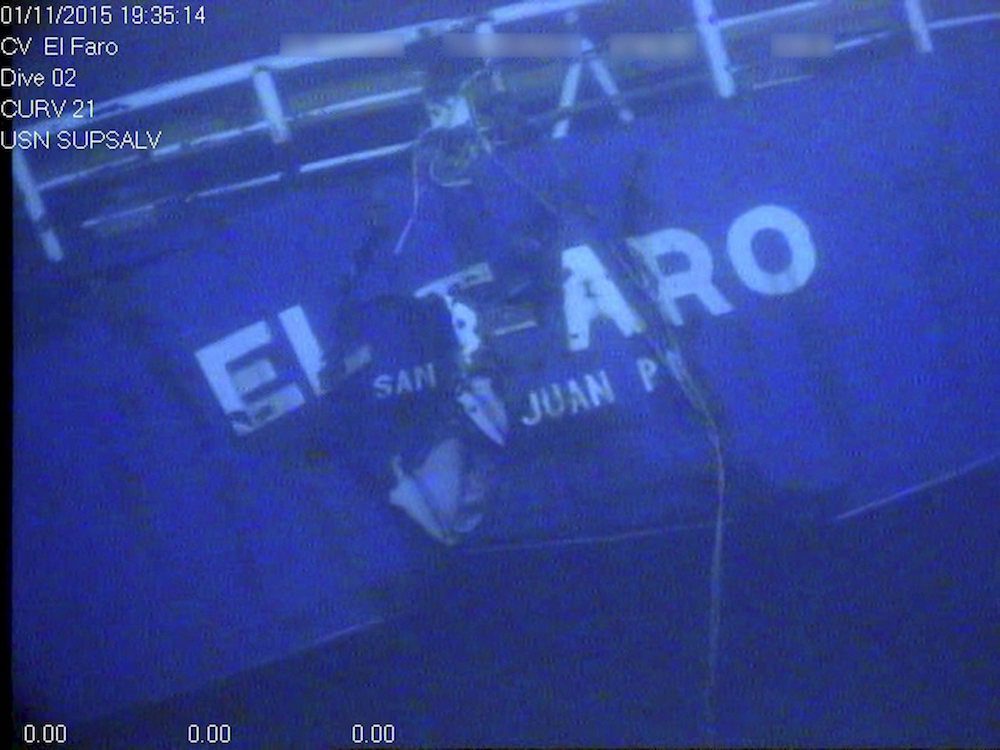The stern of the El Faro is shown on the ocean floor taken from an underwater video camera on November 1, 2015. Image courtesy NTSB via Reuters
Twenty-six hours of data and audio pulled from the El Faro’s voyage data recorder is providing investigators with important clues about the ship’s sinking during Hurricane Joaquin last October, including that the Master gave the order to abandon ship about 10 minutes before the data cuts off.
The new details were released Wednesday by the National Transportation Board after it revealed that it successfully recovered about 26 hours worth of information from the VDR, which was recovered earlier this month off the coast of the Bahamas.
Information recovered includes bridge audio, weather data and navigational data. The NTSB said that it will be convening a voyage data recorder group to help develop a detailed transcript of the sounds and discernible words captured on the El Faro’s bridge audio.
The voyage data recorder from El Faro, the American cargo ship that sank during Hurricane Joaquin in October 2015 with loss of all 33 on board, was successfully recovered from the ocean floor Aug. 8, 2016, and transported to the NTSB’s laboratory in Washington, D.C. for review. Information from the El Faro’s VDR was successfully recovered Aug. 15.
The NTSB said Wednesday that numerous events leading up to the loss of the El Faro are heard on the VDR’s audio, recorded from microphones on the ship’s bridge. The quality of the recording is degraded because of high levels of background noise, and there are other when the content of crew discussion is difficult to determine, the NTSB said. At other times the content me be able to be determined using audio filtering.
A few key points outlined today by the NTSB:
- The recording began about 5:37 a.m., Sept. 30, 2015 – about 8 hours after the El Faro departed Jacksonville, Florida, with the ship about 150 nautical miles southeast of the city.
- The bridge audio from the morning of Oct. 1, captured the master and crew discussing their actions regarding flooding and the vessel’s list.
- The vessel’s loss of propulsion was mentioned on the bridge audio about 6:13 a.m. Also captured was the master speaking on the telephone, notifying shoreside personnel of the vessel’s critical situation, and preparing to abandon ship if necessary.
- The master ordered abandon ship and sounded the alarm about 7:30 a.m., Oct. 1, 2015. The recording ended about 10 minutes later when the El Faro was about 39 nautical miles northeast of Crooked Island, Bahamas.
The times are preliminary and subject to change and final validation by the voyage data recorder group, the NTSB noted.
The VDR group’s technical experts will continue reviewing the entire recording, including crew discussions regarding the weather situation and the operation and condition of the ship.
Families of the El Faro’s crew were briefed about the results of the audition Wednesday prior to the NTSB’s release to the public.
The NTSB said it remains unknown how long it will take to develop the final transcript of the El Faro’s VDR. The length of the recording and high levels of background noise will make transcript development a time consuming process, the NTSB said.
Federal law prohibits the NTSB from releasing the audio from the VDR, but they plan to make a transcript of its contents public likely by the end of this year, the NTSB told gCaptain.

 Join The Club
Join The Club











